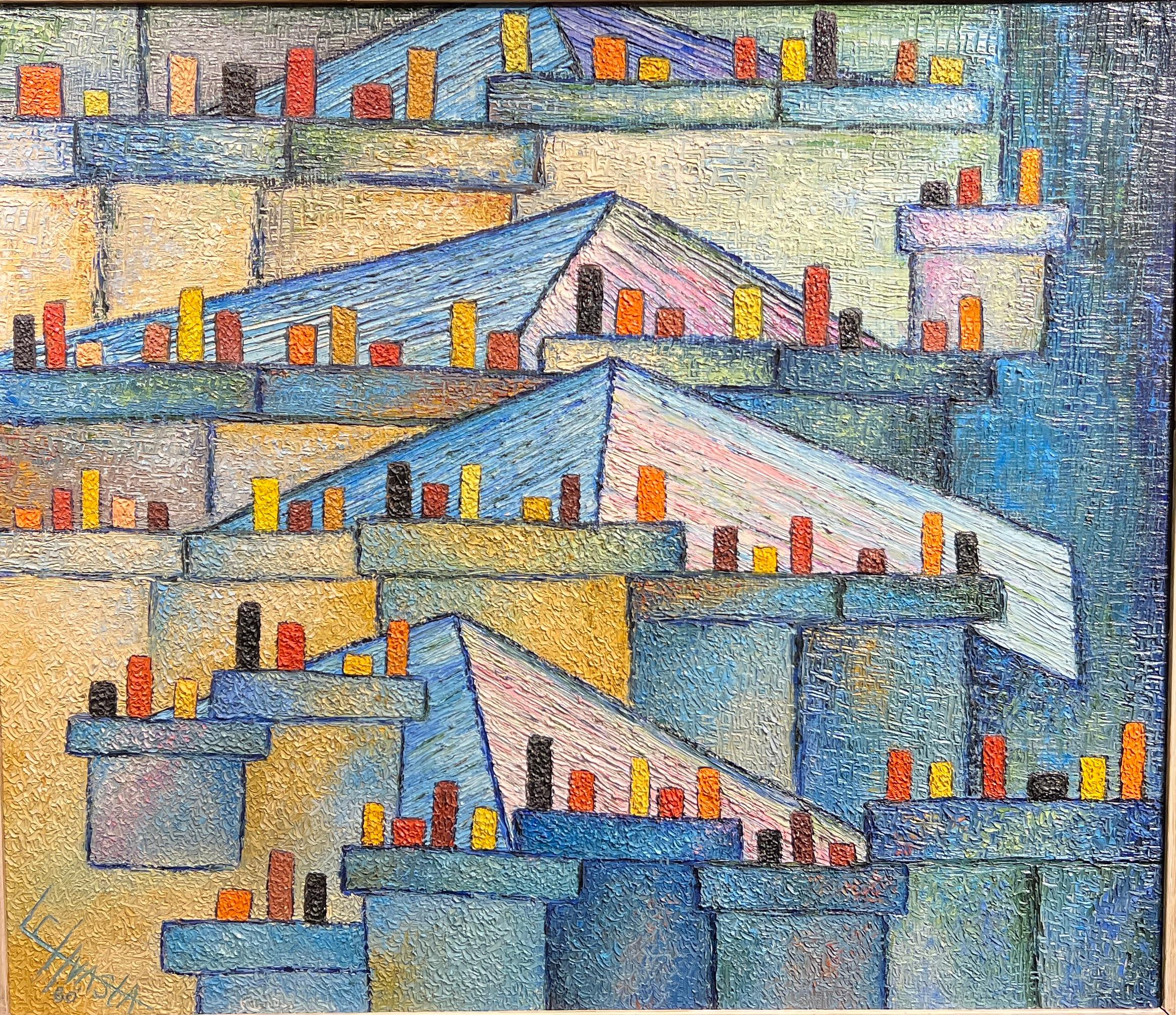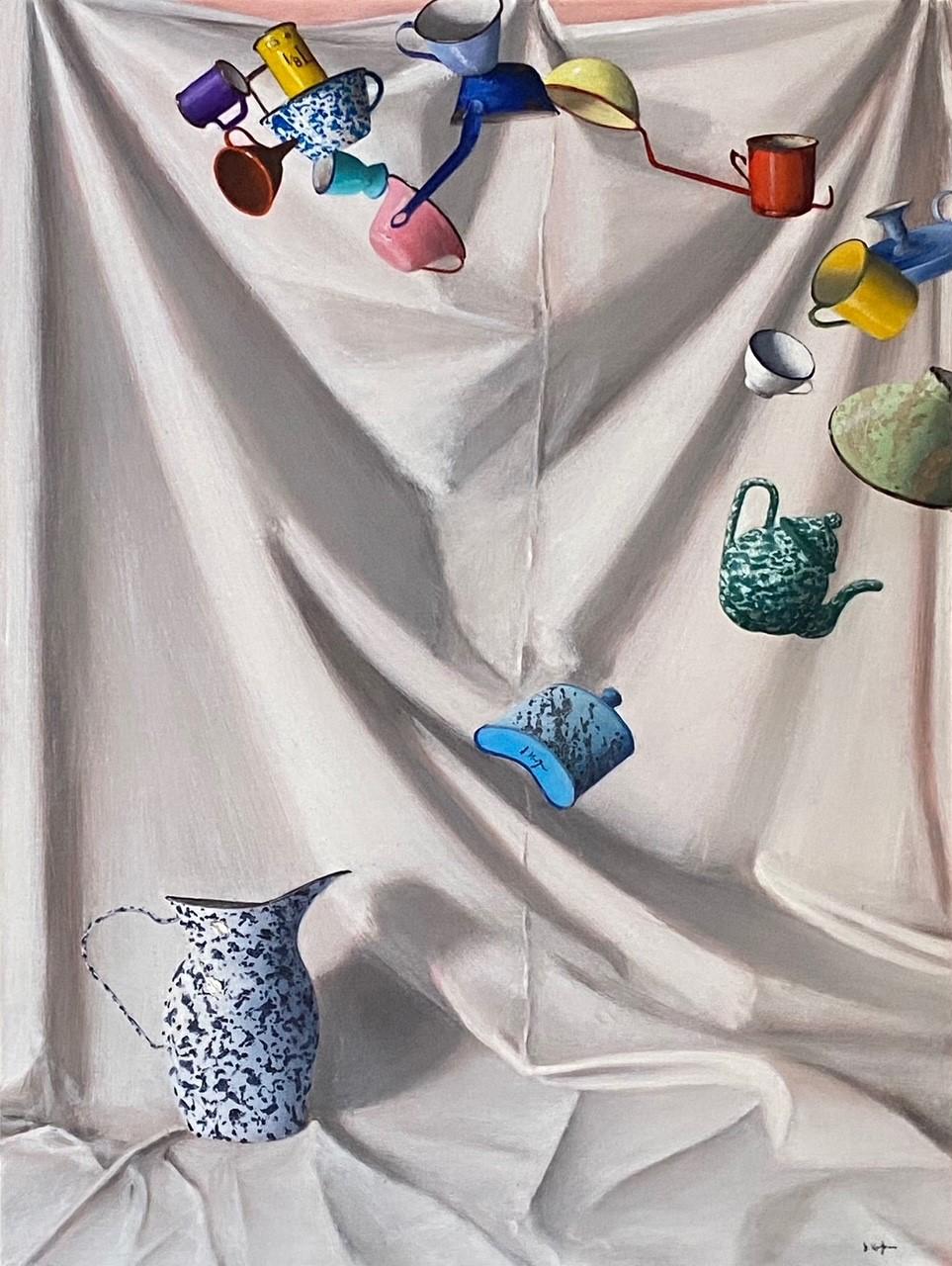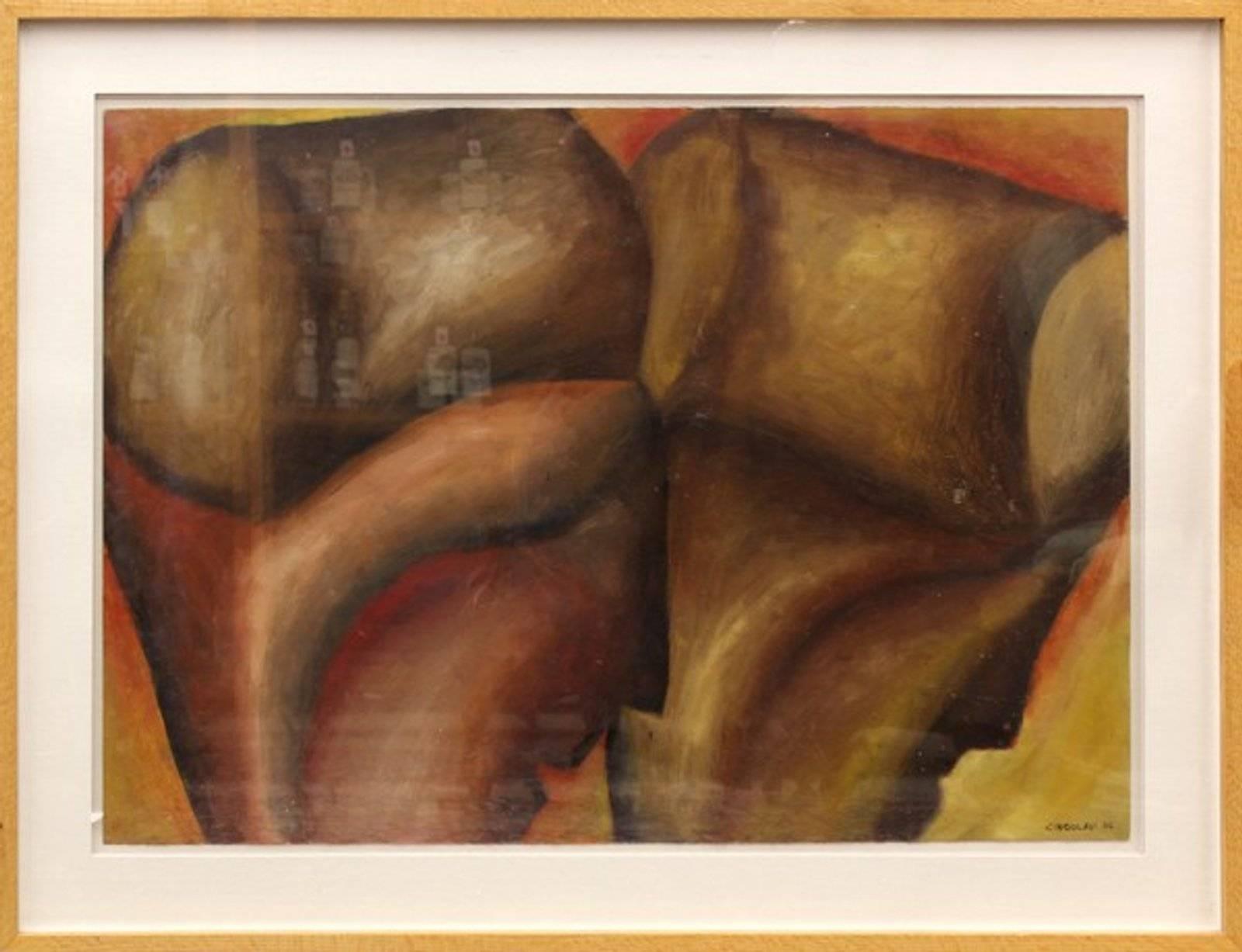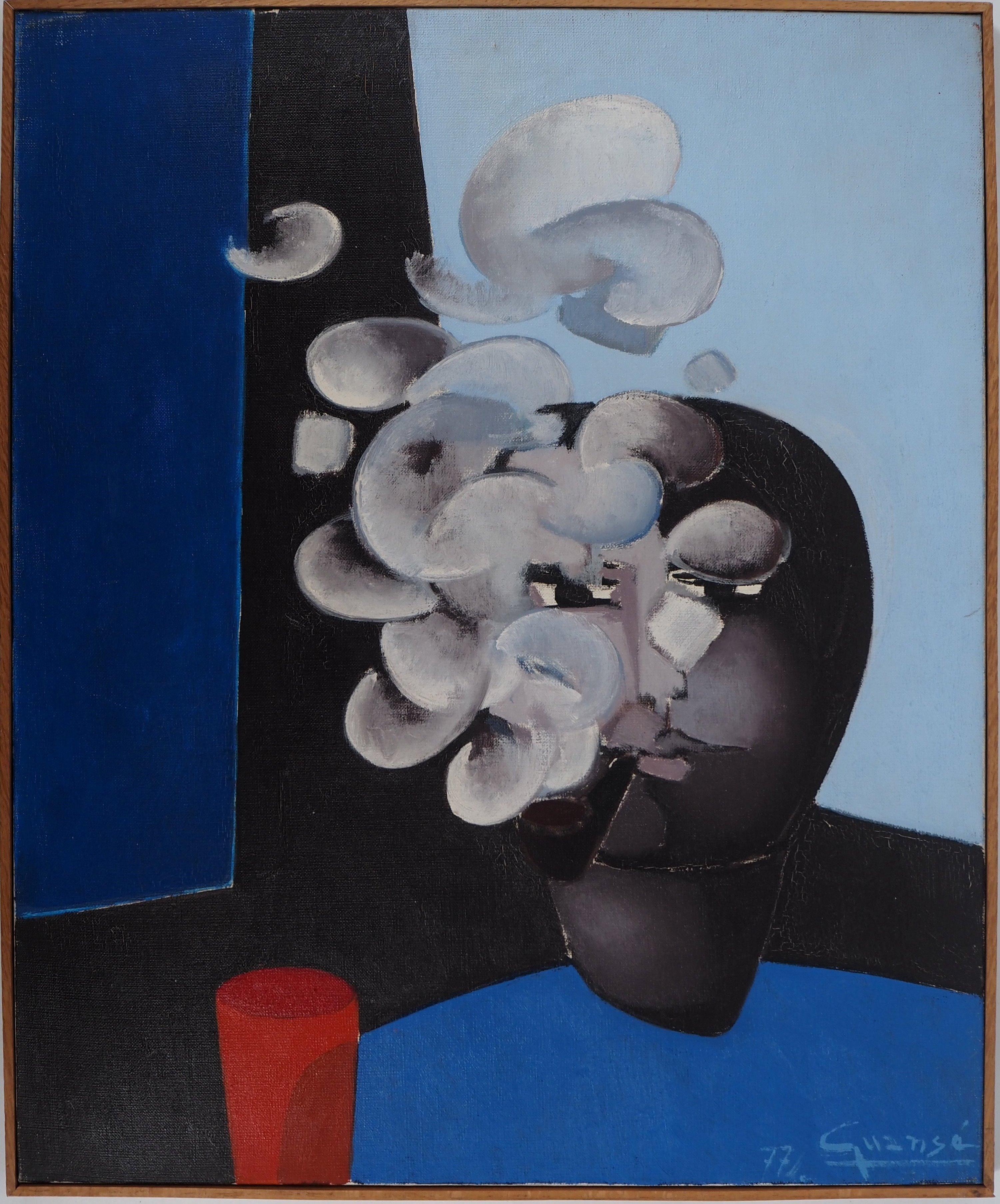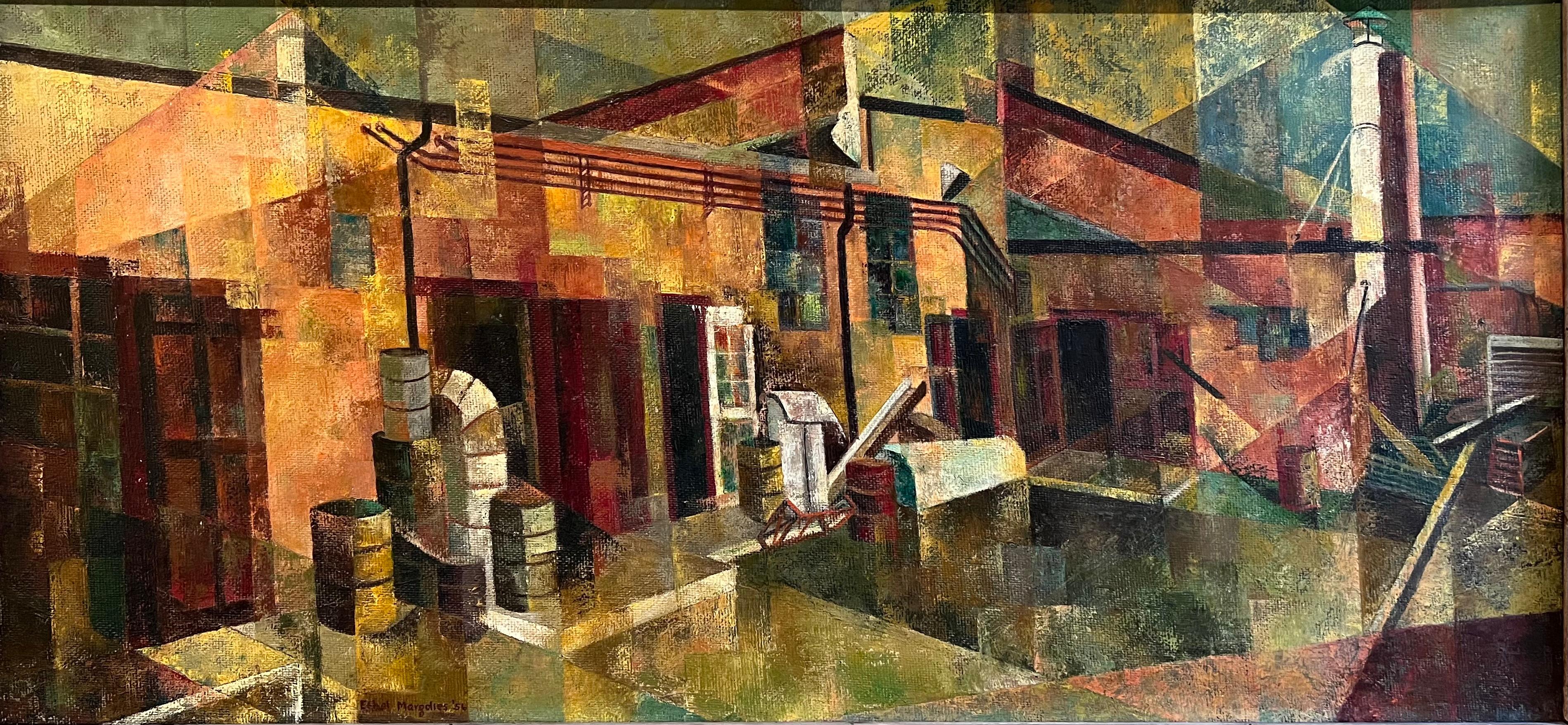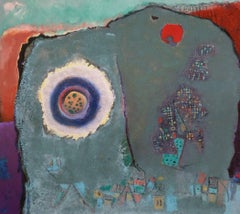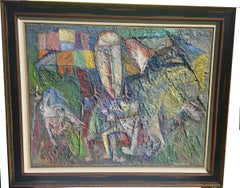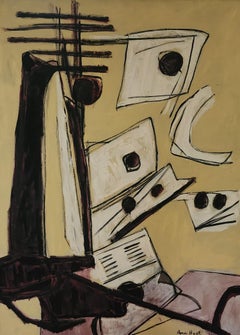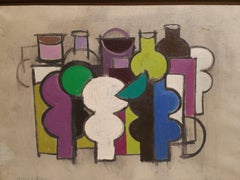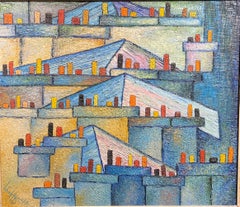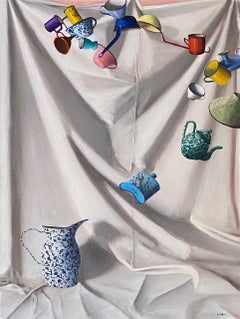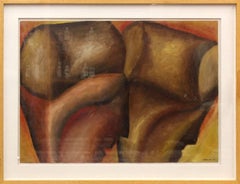Items Similar to Smoke Stacks
Want more images or videos?
Request additional images or videos from the seller
1 of 11
Miklos SubaSmoke Stacks
Price Upon Request
Price Upon Request
Price Upon Request
Price Upon Request
Price Upon Request
Price Upon Request
Price Upon Request
Price Upon Request
Price Upon Request
Price Upon Request
About the Item
Signed lower right
Miklos Suba, a Hungarian-born American artist, was a master of Precisionism, a movement that celebrated the clean lines and geometric clarity of industrial landscapes. This painting depicting factory chimneys, captured the essence of Brooklyn’s industrial transformation in the early 20th century. Suba shows elegance along with iconic form as the Suba and the Precisionist artists could convey. Suba’s architectural training lent his paintings an exacting precision, making his compositions strikingly crisp and meticulously detailed.
Suba’s fascination with Brooklyn’s industrial skyline was unparalleled. His paintings of warehouses, smokestacks, and factory facades were not merely representations of urban scenery—they were carefully orchestrated compositions that elevated industrial structures to the realm of fine art. His ability to balance realism with abstraction made his work distinct among Precisionist painters.
Today, finding an original Miklos Suba painting on the market is a rarity. His works, once exhibited at prestigious venues like the Metropolitan Museum of Art and the Whitney Museum of American Art, are now highly sought after by collectors and institutions alike. The scarcity of his best industrial paintings, combined with their historical significance, makes them prized possessions in the art world.
Suba’s legacy endures through his ability to transform the industrial landscape into something timeless and elegant. His paintings are not just records of Brooklyn’s past—they are testaments to the beauty found in precision, structure, and the modernist vision of America’s industrial age.
Bio:
Miklos Suba was born in Szatmár, Hungary in 1880. He was educated in architecture at the Royal Hungarian Technical University of Budapest, graduating in 1902. He also studied painting at the Vienna Academy in 1903 and later traveled and painted throughout England, France, the Netherlands and Italy.
He returned to Budapest to work as an architect over the next two decades. During this time he met and married his wife, May, an American pianist. The couple gave birth to their daughter, Susanne Suba, in 1913. He immigrated to the United States from Hungary in 1924 and resided with his wife May and daughter at 142 Montague Street in the Brooklyn neighborhood of Brooklyn Heights. During this time he continued to devote time to both architecture and painting.
He lived in Brooklyn Heights for the remainder of his life, later at 24 Sidney Place and finally at 69 Willow Street. With the exception of a single visit back to Hungary and a three-week stay in Chicago, he spent the rest of his life in Brooklyn. Suba died on 18 July 1944 after a brief illness. He is buried with his wife in Green-Wood Cemetery* in Brooklyn.
During Suba's time in Budapest, he painted in a traditional central European style. However, Suba's adopted city impacted a major shift in painting style from countrysides and landscapes to industrial subject matter. The rendering of buildings with clean lines and exact detail caused him to be grouped with Precisionist artists. Suba's work depicts industrialization and modernization, rendered in precise, sharply defined geometrical forms.
Of his work, Suba commented, "I try to express my realistic impressions without involking abstraction.... I am neither photographic nor reminiscent.[6] Suba restricted his paintings and drawings to areas within Brooklyn, often within walking distance of his residence. As shown in his works, Suba had an intimate relationship with his Brooklyn; from its alleys and waterways to its storefronts and industrial plants, as well as its views of Manhattan. Occasionally, he departed from his routine subject matter to others that fascinated him: barber shops, barber's poles and cigar store Indians.
Suba created scale models of barbershop poles from various locations in Brooklyn, and these models were featured in an exhibit of his work at the Brooklyn Museum in 1948. The Brooklyn Historical Society maintains a collection of twelve of Suba's scale-model barbershop poles, including working drawings and maps of the pole's locations. He incorporated barber poles in many of his paintings.
Works At Major Museums
• Ship's Funnels, 1932, The Metropolitan Museum of Art[9]
• Study for Fences, 1938–1939, Museum of Fine Arts, Boston[10]
• Atlantic Avenue, Brooklyn, c. 1939, Art Institute of Chicago[11]
• Old Blacksmith, 1940 The Metropolitan Museum of Art[12]
• Green Shutters, 1941 The Metropolitan Museum of Art[13]
• Williamsburg, 1941, Brooklyn Museum[14]
• God Bless Them, 1942, Museum of Fine Arts, Boston[15]
• 33 Fulton Street Brooklyn 2, no date, Art Institute of Chicago[16]
- Creator:Miklos Suba (1880 - 1944, American, Hungarian)
- Dimensions:Height: 17 in (43.18 cm)Width: 11 in (27.94 cm)Depth: 3 in (7.62 cm)
- Medium:
- Movement & Style:
- Period:
- Condition:
- Gallery Location:Saratoga Springs, NY
- Reference Number:1stDibs: LU17026058092
About the Seller
4.2
Vetted Professional Seller
Every seller passes strict standards for authenticity and reliability
Established in 1992
1stDibs seller since 2015
32 sales on 1stDibs
Typical response time: 16 hours
- ShippingRetrieving quote...Shipping from: Saratoga Springs, NY
- Return Policy
More From This Seller
View AllNew Year
By Enrico Donati
Located in Saratoga Springs, NY
Signed & dated verso, 1992
Enrico Donati, a surrealist and abstract expressionist painter, was born in Milan, Italy in 1909 and died in Manhattan on April 25, 2008. He was known for his association with the surrealist movement of the 1940's, but his artwork continued to transform itself through the many trends that have occurred during his long career. In Italy he attended the Universita degli Studi in Pavia where he studied economics. In 1934, he moved to the United States settling in New York where he studied at the New School for Social Research and the Art Students' League.
Considered the surviving dean of the Surrealist Movement and a member of the New York School, Donati painted with Ernst, Matta and Tanguy in the thirties and forties, and in particular with Andre Breton, regarded by many to be the grand master of Surrealism.
He helped organize the Exposition Internationale du Surrealisme in Paris in 1947 where he exhibited three of his pieces. The Surrealists were known to avoid presenting or representing reality, and put the emphasis on invention and creativity by uncovering the poetic aspect of life with its kaleidoscopic multidimensional images, using reality only to enhance imagination.
Donati survived the decline of Surrealism in the late 1940's by adapting his style to current art trends as he worked with new materials and textures throughout the 1950's.
One trend with which he became involved was Abstract Expressionism, which originated in the 1940s, and became popular in the 1950s. It was a movement in which artists typically applied paint, rapidly and with force, to large canvases, in an effort to show feelings and emotions. Paint might be applied with large brushes, sometimes dripping or even throwing it onto canvas. Abstract Expressionist work is characterized by a strong dependence on what appears to be accident and chance, although it is actually highly planned.
Donati held a retrospective at the Palais des Beaux-Arts in Brussels in 1961 and went on to exhibit at the Betty Parsons Gallery with other forerunners of American Abstract Expressionism: Mark Rothko, Barnett Newman, and Jackson Pollock. It was at this time that Donati created some of his most inventive and extraordinary work, some of which was featured in a survey exhibition at the Alter & Gil Gallery, Beverly Hills, California, in January 2000.
He has held many teaching positions and has been an active lecturer, while continuing to add to his artistic repertoire. From 1960 to 1962 he was a Visiting Lecturer at Yale University, and from 1962 to 1972 a Member of the Yale University Council for the Arts and Architecture.
He has had seventy-five one-man shows, among them an exhibit of new paintings at the Maxwell Davidson Gallery (57th St., New York) in the fall of 1997. Donati's work is held in collections throughout the world, and his work has appeared in over 300 articles and publications, two hard cover books...
Category
1990s Abstract Abstract Paintings
Materials
Cotton Canvas, Mixed Media
$25,000
Reminiscence
By Victor Khromin
Located in Saratoga Springs, NY
Signed lower right.
Provenance: Khromin Estate.
Victor Khromin, born in Gatchina City, near St. Petersburg, Russia explored his artistic abilities from the earliest years of his life. The Russian-Finish family into which Victor was born discovered and accepted his talent as something that flowed organically through their family tree. Victor's grandfather was an accomplished artist and a student of Repin at the Academy of Art in St. Petersburg, Russia.
The scenery of childhood in a small Finnish village on the outskirts of St. Petersburg continues to inspire Victor throughout his life.Victor went on to study art professionally at the Serov School of Fine Art in Leningrad. While still a student, he actively participated in non-conformist exhibitions, which were illegal during the Soviet Regime. In 1976, Victor became a member of the USSR Union of Professional Artists. This was the only Soviet organization, which could recognize an individual as a career artist. Despite membership, he continued to exhibit his works as part of the Underground Art Movement, which contradicted the code of conduct outlined by the USSR Union of Professional Artists and rejected the only officially accepted style of Socialist Realist. Victor's works stopped being presented for exhibition within official circles of the Soviet Art League. Victor became a target for government harassment and monitoring.
The 1985 solo exhibition at the Kudamm Gallery, in Berlin, served as a breaking point in the semi-tolerant relationship that had previously existed between Victor and the USSR Union of Professional Artists. According to the Union, an artist was not allowed to exhibit outside of the USSR without the permission of and censorship by that organization. That same year, Victor lost the position, which he had obtained through the Union. He relocated to a small village called Sinicheno, where over the course of 5 years, he created a series of lyrical pieces. The works were displayed at a solo exhibition at Dianart Gallery in Zurich in 1988, and at Arcole Auction, Paris in 1988-1990.The Perestroika finally opened doors for Victor to exhibit within Russia at "From Unofficial Art to Perestroika," in Leningrad in 1989 and The Stanislavski Actor's House in Leningrad in 1990.
In 1990, Victor received an invitation to come to New York City for a Solo exhibition at Nahamkin Gallery. During this trip, Victor applied for legal residency within the United States and was granted this status for his Extraordinary Abilities in Art. In 1996, Victor's paintings become part of the Norton and Nancy Dodge Collection of Nonconformist Art at Rutgers University. From this point on, Victor and his family move to rural upstate New York. Here he continues the development of unique techniques for creating 3D casts for oil paintings and paper. Victor's recent works are hand-made paper reliefs, with acrylic used as a color addition to the texture. He also developed a relining technic, which allow him to transfer his reliefs to canvas, and then work with oil paint over the underlying relief.
He has also been represented by Jane Voorhees Zimmerli Art Museum of The Norton & Nancy Dodge Collection of Nonconformist Art from the Soviet Union (1956-1986) at Rutgers University, New Brunswick, NJ; Dianart Gallery, Zurich, Switzerland; Kudam Gallery in Berlin, Germany; Codriorg Pallas Museum , Tallinn, Estonia; Urmala Exhibition Hall, Urmala, Latvia; Regional exhibition in Russia, and solo exhibitions in St. Petersburg, Russia, etc.
The specific style category...
Category
1990s Abstract Abstract Paintings
Materials
Marble
Abstraction
By Agnes Hart
Located in Saratoga Springs, NY
Signed lower right
Agnes Hart was born in Meridan, Connecticut. She studied at the Ringling School of Art in Sarasota, Florida; at Iowa State University with Josef Presser, Paul Burlin and Lucile...
Category
1950s Abstract Abstract Paintings
Materials
Sandstone
$25,000
Still Life
By Henry Kallem
Located in Saratoga Springs, NY
Signed lower left & titled verso.
A printmaker and painter in abstract style who used wide brush marks, Henry Kallem was born in Philadelphia. His father was Morris Kallem, a portrait painter, with whom he studied, and his brother was sculptor Herbert Kallem...
Category
1960s Modern Still-life Paintings
Materials
Canvas, Oil
$3,000
Abstract
By Harry Nadler
Located in Saratoga Springs, NY
Singed verso.
An abstract painter who lived in New York City; Amagansett, Long Island, and Albuquerque, New Mexico, Harry Nadler is described as a "formalist abstract painter of t...
Category
Abstract Abstract Paintings
Materials
Archival Paper, Mixed Media
$4,500
Abstract
By Rolph Scarlett
Located in Saratoga Springs, NY
Rolph Scarlett (Canadian/American, 1889 - 1984)
“Abstract”
Signed and dated 1947, lower right
Gouache on paper
Provenance: Private collection, Miami Florida
About
Rolph Scarlett w...
Category
1940s Abstract Abstract Paintings
Materials
Gouache
You May Also Like
Smokestack, bright color masks urban setting romantic realism
By Stephen Basso
Located in Brooklyn, NY
*ABOUT Stephen Basso
Stephen Basso's highly original pastels and oil paintings are romantic, yet thought provoking fantasies. His whimsical works are alive with boundless imagina...
Category
Early 2000s Neo-Expressionist Figurative Drawings and Watercolors
Materials
Pastel, Archival Paper
Chimney Pots and Roof of Paris
Located in Missouri, MO
Chimney Pots and Roof of Paris by Louis Carl Hvasta (1913-1993)
Signed and Dated Lower Left
Unframed: 24" x 28"
Framed: 34" x 37"
Frame was hand made by the artist.
A local Californ...
Category
20th Century American Realist Landscape Paintings
Materials
Oil, Panel
Price Upon Request
Tipsy Smoke
By Joseph Keiffer
Located in Greenwich, CT
Unframed Dimensions: 40 x 30 inches
Framed Dimensions: approximately 42 x 32 inches
Signed lower right
Joseph Keiffer (American, b. 1952)
Joseph Keiffer started painting at...
Category
2010s Realist Still-life Paintings
Materials
Canvas, Oil
Large Modernist Italian Oil Painting Surrealist Abstract Figures
By Marco Cingolani
Located in Surfside, FL
Marco Cingolani was born in Como in 1961 and moved to Milan at a very young age, in 1978. He began to frequent the underground creative environment, where art was mixed with fashion and punk music. In those years a new artistic sensibility was being formalized in Milan, whose roots no longer sank in the history of art and in the citation but practiced the critical manipulation of reality and its communication through the mass media.
The image was taken out of context, subtracted from the use of common sense, radically distorted, almost mocked. The work of Marco Cingolani, from the beginning, has always tried to cancel the regulatory power of media images, subjecting them to the radical care of the artist, certain that art offers a decisive point of view for the interpretation of the world. In this context the interviews of the Interviews were born, where celebrities for their privacy were submerged by the microphones and the famous series dedicated to the attack on the Pope and to the tragic story of Aldo Moro.
After having participated in numerous group exhibitions including An emerging scene (1991, Museo Pecci, Prato) and Two or three things that I know of them (1998, PAC, Milan), he is dedicated to major anthological exhibitions at prestigious public institutions such as Palazzo Strozzi in Florence and Promoter of Fine Arts in Turin. In November 2006 he took part in the collective exhibition "Senza famiglia", in the Palace of the Promoter of Fine Arts in Turin.
In 2007 Cingolani received a further consecration: the Galleria Emilio Mazzoli hosts the exhibition entitled "What color are they?" in which the pictorial reflections on the color of Power and its disguises are presented.
The art of Cingolani has always been fascinated by the passage from news to history and vice versa; also in this case the UN blue helmets, the red urn containing the electoral ballots, the multicolored segments of the Wall Street charts, the military uniforms and the party flags are contextualized in highly symbolic scenarios.
In 2009 a return to the origins for Marco Cingolani, often the author of works expressly inspired by the religious theme. In particular, for this exhibition entitled " Percorsi della Fede", the artist focused his attention on the Marian apparitions that have marked the last two centuries: Lourdes and Fatima . In the same year an exhibition in Lucca at the National Museum of Villa Guinigi, joins him to some of the leading Italian artists of the last two generations; by the universally recognized and celebrated masters, present in the main international museums such as Mimmo Paladino, Sandro Chia, Salvo, passing through some of the protagonists of the 52nd Venice Biennale as Gian Marco Montesano, Daniele Galliano, Nicola Bolla, Bertozzi & Casoni who exhibited in 2009 in contemporary at the Lucca exhibition and at the Italian Pavilion of the Venetian event, to get to the young artists of the last generation already present in important national and international artistic events.
Giacinto di Pietrantonio invites him the following year, 2010 to PAC, Pavilion of contemporary art in Milan, for the collective exhibition "Hybrid", alongside Jan Fabre, Gilbert & George, Charles Avery, Damien Hirst, Piotr Uklanski, Patrick Tuttofuoco and other great ones on the international scene.
2012 is the year of "Il Belpaese dell'arte", at Gamec di Bergamo, always curated by Pietrantonio and Maria Cristina Rodeschini, in the company of Elmgreen...
Category
1980s Surrealist Abstract Paintings
Materials
Paper, Oil
Surrealist Pipe Smoker - Original Oil on Canvas, SIGNED
Located in Paris, IDF
Antonio GUANSE (1926-2008)
Pipe Smoker, 1977
Oil on canvas
Signed and dated
Countersigned and dated on the back
On canvas 61 x 50 cm
Presented with the wooden frame 62.5 x 51 cm
Ve...
Category
1970s Surrealist Portrait Paintings
Materials
Oil
Three Chimneys
Located in Los Angeles, CA
Three Chimneys, 1956, oil on Masonite, signed and dated lower left, 18 x 36 inches, titled verso, presented in its original frame
Three Chimneys is a prime example of Ethel Margolies’ Precisionist-influenced industrial scenes. Throughout the 1950s and 1960s, Margolies made a name for herself by painting the Northeast’s factories, foundries, and manufacturing plants. Although this subject matter is often associated with male artists, Margolies is part of an important lineage of female modernists who depicted symbols of America’s industrial might. Starting with artists like New Jersey’s Elsie Driggs and Chicago’s Yvonne Deluc Pryor, Margolies is part of a through line of women Precisionist painters that also included the West Coast’s Vanessa Helder. Whereas these artists tended towards a stark and pristine realism, Margolies seems to have been influenced by the 1920s and early 1930s work of Charles Demuth’s and Charles Sheeler’s highly designed paintings from the same period, as both adopted a cubo-futurist oriented brand of Precisionism.
Ethel Polacheck Margolies was a Connecticut painter...
Category
1950s American Modern Landscape Paintings
Materials
Masonite, Oil
